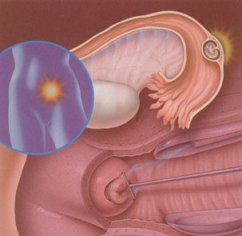Tubal pregnancy is also known as ectopic pregnancy. It is a pregnancy that develops outside the uterus (womb).
In other words, it is a pregnancy where fully fertilized egg from the ovary simply places itself outside the uterus for gestation.
Tubal pregnancy occurs when the fertilized egg resides in a fallopian tube rather than transferring to the uterus, where it is need to embed. The egg gets stuck when a tube is damaged, scarred, or distorted.
The most common place that fertilized egg places itself is within one of the fallopian tubes, the tubes that transfer the egg from the ovary to the uterus. Tubal pregnancies also take place on the outer surface of the uterus, on the ovaries, or connect to the bowel.
Tubal pregnancy is the major cause of death in the early stages of pregnancy. The risk factors associated with tubal pregnancy are pelvic inflammatory disease (PID), infertility, endometriosis, earlier tubal pregnancy, earlier abdominal or pelvic surgery, and earlier tubal ligation and usage of intrauterine device.
Tubal pregnancy generally occurs in the first five to ten weeks of pregnancy. Consult your doctor if you experience heavy vaginal bleeding or severe pain. Your doctor will perform a pelvic test to trace the areas causing pain as well as to check for the uterus size and recommend having urine pregnancy test to confirm your pregnancy.
On the other hand, if you already confirmed your pregnancy, the doctor will recommend having blood tests to measure the HCG levels. If the HCG levels are lower than normal for your pregnancy stage, it signs for tubal pregnancy.
Thus, an ultrasound test will be recommended to determine the position of your pregnancy. It is generally suggested when your vaginal bleeding is heavy or the condition becomes life threatening.
Remember that an ultrasound test is a type of imaging through sound waves. It is extremely painless. However, every ectopic pregnancy cannot be detected through ultrasound test. If tubal pregnancy is determined then your doctor proceeds to the treatment options based on your condition.
Culdocentesis is another test that is performed very rarely to observe internal bleeding. During this test, your doctor will insert a needle into the space on top of the vagina. Any blood or fluid found on the needle indicates it from a ruptured ectopic pregnancy.
Keep in mind that tubal pregnancy does not signify a developing baby. It can be life threatening and need immediate treatment. However, the treatment for tubal pregnancy depends on the size and location of pregnancy as well as your personal preference regarding future pregnancy.
Medicine, surgery, or both can be used to treat tubal pregnancy. If the tubal pregnancy is very small and in the fallopian tube, you may be treated with an injection of methotrexate, without damaging the fallopian tubes and other organs, to break up the fertilized egg and to expel it from the body.
On the other hand, laparoscopic surgery is most often used to remove the tubal pregnancy when it is large or outside the fallopian tube.






